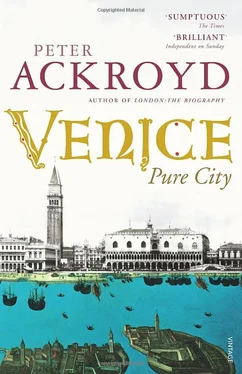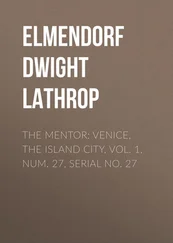2
Water, Water Everywhere
Venice was, until the building of a railway bridge in the middle of the nineteenth century, a small island, or collection of islands. Venetians were islanders, with all the benefits and burdens that accrue to that especial status. To be insular is to be independent; but it is also to be alone. It secures a measure of safety, but it also attracts attention from those on the larger mainland. It exemplifies vulnerability, even when outward circumstances seem favourable. Yet as an island city Venice survived all the wars and invasions that have beset Italy since the eleventh century; it successfully defied both pope and emperor, French invasion and Spanish incursion, and the continual forays of the other city-states of Italy. If it had not been surrounded by water, it would have been destroyed many centuries ago.
But that separation from the mainland, from Italy and the world, has taken its own toll. Although Venice has been part of Italy since 1866, Italy has largely ignored it. It is considered as somehow extraneous. The Italians do not really think of Venice at all; it belongs to some other realm of fancy or of artifice. On the part of the Venetians the tradition of liberty, and of freedom from the fear of invasion, bred a certain insouciance. The island guaranteed the citizens their self-sufficiency, perhaps, but it also encouraged a certain self-enclosed or self-referential attitude towards the rest of the world. It is still easy, in Venice, to grow indifferent to what is happening elsewhere. Venetians themselves are not particularly concerned with the affairs of what might be called the wider community. From the remoteness, and isolation, can also spring melancholy. Venice is no longer an island, but the island temperament remains.
And of course the islanders must always look out to sea. It is their context. It is their horizon. Where would they be without the sea? The city rests on the silt at the bottom of the sea. It is as much a part of the sea as the tides and the waves. The sea flows between the wooden piles that sustain it. The sea flushes beneath it. There is something innately unsettling about living in Venice. There is salt in the air, and the atmosphere is rendered hazy by evaporation. The haze easily becomes sea mist or sea fog. The air seems to melt above the buildings. The salt and damp leave silvery traces on the whitened walls, as if they were made out of mother-of-pearl. The birds flying above them are the seagulls. And there is seaweed floating along the canals beside them.
So there are images of the sea throughout Venice. The floor of the basilica of Saint Mark gently undulates, as if the congregation were walking upon waves. The area of marble slabs, on the floor of the central crossing of that church, was known in the sixteenth century as il mare . The marble columns of Saint Mark’s are veined or striated like the waves. In the other churches of the city we might note the popularity of “dolphin capitals” and the motif of the shell. Ruskin described the imposing houses along the Grand Canal as “sea-palaces.” In maps of Venice, particularly those from the seventeenth and eighteenth centuries, the shape of the city is reminiscent of a fish or dolphin. The islands and sand-ridges, out of which Venice was made, seemed to the first settlers like the backs or dorsi of slumbering whales; one area of modern Venice is still called Dorsoduro or hard back. On top of one of the two presiding pillars in the piazzetta, Saint Theodore is astride a crocodile. There are crabs and dolphins on the capitals of the ducal palace. It would not be wonderful to meet a leviathan, or what in Moby-Dick Herman Melville calls “strange shapes of the unwarped primal world,” swimming at times of acqua alta in Saint Mark’s Square. It would not be wonderful to see a great polyp or medusa wallowing in the Grand Canal. It is a sea city.
The first impression of Venice may also be one of the sea. Goethe saw the sea for the first time in his life when he came to the city in the autumn of 1786; he glimpsed the Adriatic from the arched window of the campanile in Saint Mark’s Square. Ruskin arrived in Venice some fifty-five years later and, in his autobiography, he writes that “the beginning of everything was in seeing the gondola-beak come actually inside the door at [the hotel] Danieli’s, when the tide was up, and the water two feet deep at the foot of the stairs.” To find the waves of the Adriatic lapping within the city—to find the sea changing the nature of the stone buildings all around him—that was the great enchantment. The moon rules Venice. It is built on ocean shells and ocean ground; it has the aspect of infinity. It is the floating world.
The sea embodies all that is changing and variable and accidental. It is the restless and wilful element. It emerges in endless variations of colour and surface pattern. The paintings of Titian and Tintoretto have been said to manifest a “sea” of light, in which shape is fluid and ambiguous; the Venetian school of painting has been characterised as one of flowing colour rather than of form and outline, a curvilinear impulse that creates its own weight and volume. All is in flux. You glimpse the movement of the sea in Venetian statuary as well as Venetian painting. The mosaics of the city favour the depiction of the various biblical legends of the sea. Thus in the basilica of Saint Mark’s can be found “The Miraculous Draught of Fishes,” “His Walking on the Water” and “The Stilling of the Tempest.” There are certain churches that might have risen out of Neptune’s kingdom. The church of the Gesuiti, or S. Maria Assunta, has a baroque interior in which great cascades of grey and green and white marble are supposed to imitate wall hangings. But they more closely resemble waves, waves flowing and crashing down the sides of the church until arrested in a moment of silence and stillness. The floor of green marble might have furnished some cave beneath the ocean, as rays of light penetrate the marine gloom of the interior.
The rhythmic intelligence of the Venetians has informed much of the architecture of the city. The oncoming sea changes the perception of structure along the Venetian canals, where the buildings seem more delicate and attenuated. The façades of the churches undulate, weightless and unstable, against the surface of the water like shells at the bottom of a rock pool on the seashore. The architecture of Venice is horizontal in mass, like the sea. From a distance, across the lagoon, the impression of the city is of flatness along the horizon. It is perpetually in motion. It is baroque and mannerist rather than classical; it shimmers, as if seen through water; it is encrusted with ornament like a coral reef.
Venetian craftsmen were well known for their work in satin, where the gleamings and shimmerings of a particular fabric were known as “watered silk.” To work in silk was known in Venice as dar’onda all’amuer , or to make waves on the sea. There is an especial type of Venetian risotto, more liquid than elsewhere, that is known as all’onda or with waves. A sponge found in the Aegean is known as enetikos or the Venetian. In the last century you could buy in the tourist shops of Venice small ornaments made from the pearl shells found in the Lido, known as fiori di mare or the flowers of the sea. They are the only flowers indigenous to Venice.
There are other deep correlations between place and spirit. Venetian society has been described as fluid and ever-changing. Of Venetian politics Sir Henry Wotton, the English ambassador to Venice in the early seventeenth century, said that it “fluctuated, like the element of which the city was built.” That is the reason why Venetian historiographers were intent upon emphasising the continuity and stability of their society. They were always aware of the motion and restlessness of the sea within Venetian polity. At the heart of la Serenissima was a horror of transience, like the Venetian sailor’s dread of the sea. As the Venetian poet of the late sixteenth century, Veronica Franco, put it, “the sea itself yearns towards this city.” This may be considered a compliment, as long as the sea does not come too close.
Читать дальше












